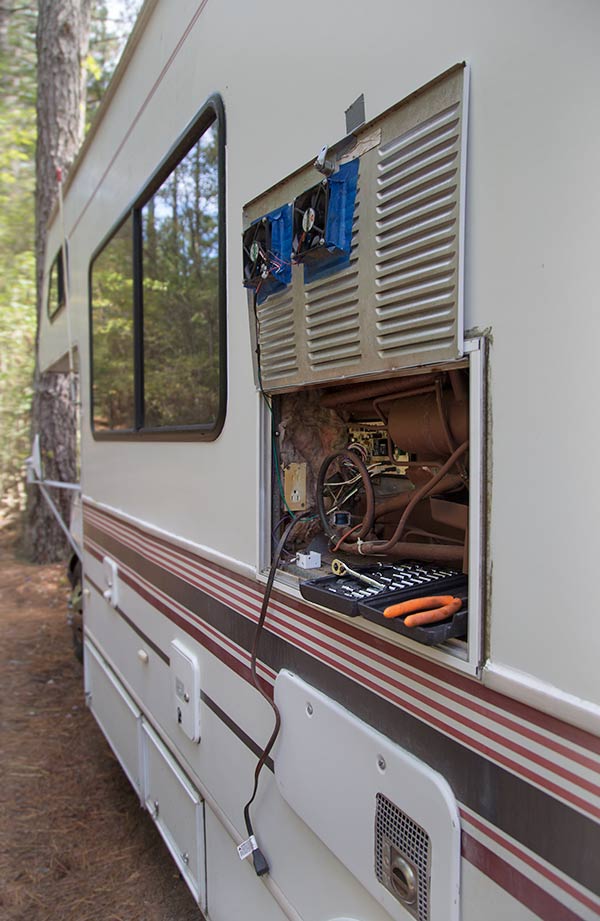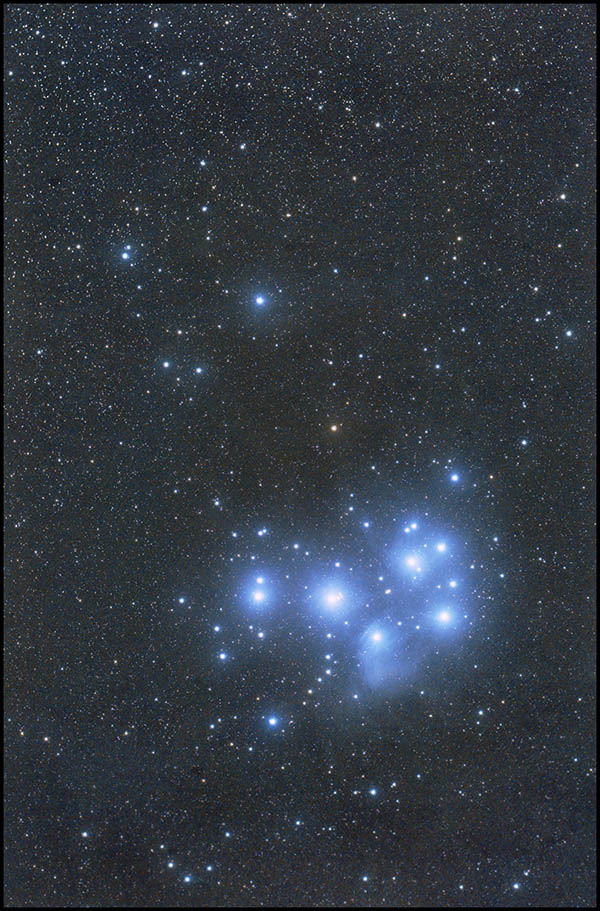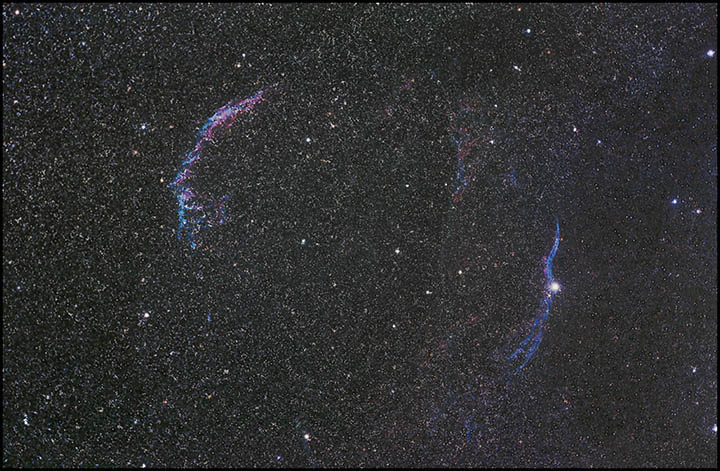Signs of Fall
10/6/2015. October's bright blue skies, football on the weekends, pumpkins on the porch, and the MLB post-season ready to commence, but the real sign that fall is here is this: I just brought the water cooling kit inside, rinsed the pump, tubing, and reservoir (a pickle jar) with a weak Clorox solution, and put them away. In any season but summer, the camera's Peltier cooler suffices. I took this out by the Ritchey last summer when nighttime lows failed to drop out of the seventies. Then the sky closed down. Now that there's a renewed prospect of starlight, we're seeing predawn temperatures in the upper 40's again. Ah.

"It was one of those things they keep in a jar in the tent of a sideshow
on the outskirts of a little, drowsy town.” —Ray Bradbury, "The Jar."

"Man, look at that. There's one whole side of that [thing] missing..."
—James Lovell, on seeing the remains of the Apollo 13 Service Module
All right, settle down. It's not that bad. The Norcold N641 2-way refrigerator in the RV developed a problem. Wouldn't turn off. The only way to shut it off and stop it complaining that the flame was out or there was no AC current was to turn off the DC current to the monitoring and control circuits. But that left the RV dark, with no power for the water pump, fans, reading lights, etc. The 'fridge was installed by Larry back in 2007, so there's no room to be upset that it's showing some age. And on the 'net, I found similar tales of woe. The fix in all cases was to replace the power board. That's on the back of the refrigerator which sounds terrible, as if you have to pull the unit out, but it's actually accessible behind this panel on the driver's side. Open it up, remove a plastic cover, unplug several wires, fit a replacement board (choose carefully, there are similar options that will not work), reattach the wires, replace the cover, close the hatch and prepare for re-entry. Simple. Failure is not an option.
2015/10/07. I set up in the cul de sac for the first time in 3 weeks. The ClearSkyClock promised clear weather all night. Didn't happen. I lined up on the Veil and planned a multi-hour run, but clouds cut me off in 30 minutes. When I walked up to pick up the memory card and save some battery power, I found the 12v DC connection to the computer cycling off and on every second or so [probably owing to a loose and unlatched battery, found in the a.m.]. I pulled out a small inverter and a big battery and recharged the computer while I waited for the clouds to move through. When I returned under starry skies two and a half hours later, I discovered that I had misjudged my place in the cul de sac, and the Veil was minutes from the trees. I picked a new target, recalibrated, set my cut-off timers (one for the mount, one for the computer) and left the camera shooting the Pleiades (I still don't have a photo of them with which I am really pleased).

The Veil
6D, AT65EDQ, 6x180s, iso 3200
(I have a bigger version, go ahead and click the image.
But let's see if there's a better image to enlarge soon.
Yeppers, look at the next Veil image.)
I'm not paticularly happy with the composition. 52 Cygni needs to be framed closer to the horizontal midline so that more of the nebulosity that trails off the bottom of this frame is included. OK, I can take two cuts at a target here. Try not to do that out younder. Also, it's awfully blue, probably because the Veil is bright in two narrow wavelengths and while 6D is sensitive to the O-III wavelength it is relatively blind to H-a. To do this right, I'll need to use the modified 50D (too).
 After midnight, I had the 6D take images until its battery died (4h45m). A mechanical timer shut off the G11 at about 6:00 AM, and I'd set a Windows event to turn off the computer a few minutes before that. In the morning, the Kendrick was still above 13v and the computer showed 50% power remaining. The first several images were noticeably degraded by thin clouds, so I stacked only the final 76. I'm still not happy with my Pleiades portrait. For one thing, the star images are peculiar, possibly, probably, I hope, owing to encroachment by the casual dewshield (a rolled up bit of Protostar flocking). A full-size sample showing a couple of bright stars is at right. I've hidden some of that wierdness with a small dose of starspikes in the image below:
After midnight, I had the 6D take images until its battery died (4h45m). A mechanical timer shut off the G11 at about 6:00 AM, and I'd set a Windows event to turn off the computer a few minutes before that. In the morning, the Kendrick was still above 13v and the computer showed 50% power remaining. The first several images were noticeably degraded by thin clouds, so I stacked only the final 76. I'm still not happy with my Pleiades portrait. For one thing, the star images are peculiar, possibly, probably, I hope, owing to encroachment by the casual dewshield (a rolled up bit of Protostar flocking). A full-size sample showing a couple of bright stars is at right. I've hidden some of that wierdness with a small dose of starspikes in the image below:

M45, the Pleiades
76x180s (3h48m)
Canon 6D, ISO 1600, AT65EDQ
(click it for a better look)
There's a lot of interesting stuff going on around that cluster. Now that we've got the electronics, the mount, the guiding, the optics (mostly) squared away, I'm going to need to get serious about image calibration. These two really could use darks, and flats are always helpful.
10/08/2015. Setting up in the dark took three times as long as setting up in twilight. Remember that. I took 2.5 hours of the Veil, then tried a vertical composition of the Pleiades. That nebulous stuff in the upper left of last night's frame needs a closer look.
The Kendrick battery pack read 13v when I started about 9:45, but at half past midnight, the G11 was flashing a low voltage alarm and the Kendrick read 7.8v. Good to know the mount will hang in there that low. I hooked the G11 up to a spare auto battery (left over from the RV), made an extra trip to get a spare camera battery, started the series of the Pleiades and only now realize that I probably left the camera on ISO 3200 rather than 1600. Tomorrow: check / change the batteries in the intervalometer. Tighten the focuser on the AT65EDQ. See if you can eliminate the play in the T-adapter without introducing tilt (yes, there are three straight-slot set screws and they must all be dead tight).
The Veil is better (but is it really that much better considering that the exposure is so much longer? The difference shows up when comparing the enlarged versions. Now would you please shoot some darks and flats?).

The Veil Nebula
52x180s
I could hire myself out as a rain cloud maker. Aim at the Pleiades, clouds slide in. I took 80-ish frames, got 15 reasonably clear ones. Some fine night, I'm going to get this shot. This time earthly clouds are masquarading as celestial ones:

The Pleiades
15x180s
Don't bother enlarging it. Next time for sure.
At least we know that the wierd stars were produced by the dew shield: I left it off this time and the point spread function is much better behaved. And even though I exposed this at ISO 3200 rather than the intended ISO 1600, the histogram is still perfectly manageable and noise still averages out nicely. Now shoot some darks at likely ISO's and temperatures and and exposure times and get serious.
2015/10/09. Happy 90th Mom! I updated Pixinsight, and I shot darks and bias frames. Then I reprocessed some of my recent work. I've been doing it wrong. While figuring out how to produce the master dark frame, I found that I have been unnecessarily working at reduced resolution. Something something in the de-Bayer step, somewhere along the way from chip to computer. Now that I have full-sized darks and bias frames --flats to come-- I'm starting over with the automated stacking script in Pixinsight. At least the calibration, alignment, and integration steps are all being taken care of in one package now, and it's just a matter of tweaking a ton of options to regain full control.
I also found that the camera was out of plane while shooting the most recent images: stars on the left side of the Veil are seriously defocused compared to stars on the right as are stars on the bottom of the Pleiades image. Tightening up the T-adapter may have already fixed that. For what it's worth, Pixinsight reports that there are 14,000 - 18,000 stars in the images of the Veil. I can't wait to turn this new workflow loose on the images of M22 from a few weeks back just to see the number (see below).
2015/10/10 Another cut with old data and new! improved! post-processing workflow including bias frames, imperfect darks, and rudimentary flats. Colors are much better, there are 4x as many pixels to work with, and the processing took a while (4h40m). Rule of thumb: with 3-minute subs, this computer and this workflow, calibration, alignment, and integration time in PixInsight equals about twice the exposure time; that's twice as long as with my previous workflow, but the results are noticeably better.

The Veil Nebula in Cygnus
52x180s
Click the image to look more closely.
Promising! But note the progressively larger point-spreads from right to left. On the right, stars are nice and tight; on the left, they expand to several defocused pixels. That's a mechanical issue, already addressed (I hope). I've made some crude adjustments in post-processing to tighten up the stars on the left but they rendered them a little strange on the right --down the middle, all is peachy. I could possibly address the fault much more successfully using morphological transforms in Pixinsight. All in all, let's just fix the problem and reshoot.
BTW, the subframes for the vertical Pleiades photo are said by Pixinsight's alignment routines to contain about 9,000 stars, the Veil Nebula subs between 14,000 and 18,000, and the M22 subframes for the photo a few pages back contain up to 38,000. The finished photos, of course, show quite a few more than the subframes.
Except where noted, deep-sky photos are made with an SBIG ST2000XM CCD behind a 10-inch Astro-Tech Ritchey-Chretien carried on an Astro-Physics Mach1GTO. The CCD is equipped with Baader wide- and narrow-band filters. The internal guide chip of the CCD most often keeps the OTA pointed in the right direction (I'll let you know when an OAG or guidescope takes its place). Camera control and guiding are handled by Maxim DL 5.12. The stock focuser on the AT10RC has been augmented with Robofocus 3.0.9 using adapters turned on the lathe downstairs. A Canon 6D and a modded 50D find themselves mounted on an Orion 10" F4 Newtonian or carrying widefield glass on an iOptron Skytracker. Beginning in May 2013, PixInsight has taken over more and more of the heavy lifting -- alignment, stacking, gradient removal, noise-reduction, transfer function modification, color calibration, and deconvolution. Photoshop CS4 et seq and the Focus Magic plugin get their licks in, too.
:: top ::